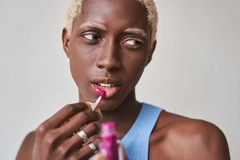Novel Neurocosmetics: Understanding the skin-brain axis’ influence on cosmetics

Neurocosmetics is emerging as an important field in the personal care industry, offering skin care that interacts with the nervous system to promote both skin health and emotional well-being. Brands are increasingly incorporating neuroactive ingredients that claim to influence the brain-skin connection, as consumers seek products that go beyond surface-level benefits.
Innova Market Insights data indicates a 3% growth in personal care launches with the “neuro’’ claim mentioned from 2020 to 2024.
According to the market researcher’s Beauty and Personal Care Survey 2025, 62% of consumers globally agreed that their beauty and personal care routine is important to their mental “wellness.” Some 30% of consumers said that they have spent more in the last 12 months on beauty and personal care products to uplift their mood.
Personal Care Insights speaks to Givaudan Active Beauty, neuroactive skin care specialist ID Swiss Botanicals, Symrise, and FAAD board-certified dermatologist Dr. Pooja Rambhia, practicing at UnionDerm in New York, US, about the neurocosmetics trend and how it is poised to influence the beauty industry.
“Once a niche segment dominated by indie brands, neurocosmetics are now attracting major industry players who are reshaping the market with innovative value propositions. This category is no longer on the sidelines — it’s stepping into the spotlight. Beauty aisles are being redefined, with brands that challenge traditional norms, merging science, self-care, and education to create effective and inclusive solutions,” says Dr. Fabrice Lefevre, marketing innovation director at Givaudan Active Beauty.
The science behind neurocosmetics
According to Rambhia, the skin and brain communicate continuously via neural, hormonal, and immune pathways. This “skin-brain axis” allows sensory information from skin receptors to reach the brain while the skin responds to brain-produced neurotransmitters and hormones.
“When you touch something hot, specialized temperature receptors in your skin immediately send danger signals to your brain, triggering a rapid withdrawal reflex. Conversely, during periods of stress, your brain releases cortisol (a stress hormone), which skin cells detect through specific receptors,” she says.
This occurrence can lead to increased oil production, inflammation, and reduced barrier function, which causes many people to experience acne flare-ups or eczema during stressful times.
“This bidirectional communication demonstrates how sensory information travels from skin to brain, while brain-produced chemicals directly affect skin function and health,” Rambhia says.
 Consumers are becoming increasingly focused on the skin-brain axis.“Skin care products can influence this relationship through sensory properties, ingredients that interact with neural receptors, and their ability to reduce inflammation and support barrier function.”
Consumers are becoming increasingly focused on the skin-brain axis.“Skin care products can influence this relationship through sensory properties, ingredients that interact with neural receptors, and their ability to reduce inflammation and support barrier function.”
Dr. Rambhia says certain neurocosmetic ingredients have been studied for their potential to influence mood and stress levels through skin-brain interactions. Peptides like acetyl hexapeptide-8 (Argireline) may promote relaxation by reducing muscle contractions, while adaptogens such as ashwagandha and Centella asiatica help lower cortisol and support the skin barrier.
Neurocosmetics on the rise
The neurocosmetics market continues to grow as consumers become more aware of the connection between mental well-being and skin care. According to ID Swiss Botanicals’ founders Aude and Cedric Rimella, the neurocosmetics market is still emerging but its growth is accelerating fast, fueled by the increasing demand for science-backed skin care solutions that work with the skin’s biological intelligence.
“The global neurocosmetics and brain-skin connection market is expected to see double-digit growth over the next five years,” the Rimellas say.
The brand cites the rise of stress-related skin concerns as one of the biggest drivers of the category’s projected growth.
Lefevre at Givaudan shares this notion. The company’s research shows that 87% of consumers currently recognize that mental health is just as important as physical health. “Even before COVID-19, the relentless pace of modern life had already made stress a major concern — 77% of people regularly experience stress-induced physical symptoms, impacting both their skin and overall well-being,” says Lefevre.
“Since the pandemic, this demand for well-being has accelerated dramatically, now ranking as the second most important priority after skin health.”
Heloise Bouchez, global product manager for Advanced Actives at Symrise, says that consumers are no longer satisfied with surface-level skin care, but are rather “opting for solutions that also support mental health, emotional balance and help to relieve stress.”
Gen Z is emerging as a major driver of the demand: “Eighty percent use beauty products as a tool to support their mental health, and 76% consider emotional and mental well-being a key factor in their purchasing decisions,” says Lefevre.
According to Lefevre, neurocosmetics is the direct, science-backed answer to this unmet need, bridging skin care and mental wellness in a way that resonates with today’s consumers.
Mood enhancing misconceptions
As consumers become increasingly focused on the skin-brain axis, neurocosmetics is positioned to evolve toward incorporating more vigorous clinical research to validate their effects, moving beyond basic science studies of individual ingredients.
Dr. Rhambia says a common misconception about neurocosmetics is that they directly alter mood like a drug. In reality, their effects are localized to skin responses, such as reducing sensitivity or inflammation, and may improve mood by virtue of that.
Additionally, while certain ingredients like peptides, adaptogens, and CBD show promise in basic science studies, she says there is extremely limited clinical data on their efficacy in clinically tested final skin care formulations. Eighty percent of Gen Z use beauty products as a tool to support their mental health.
Eighty percent of Gen Z use beauty products as a tool to support their mental health.
Advancements in biotechnology could also refine neuroactive peptides and adaptogens for better skin penetration and efficacy; however, for neurocosmetics to gain credibility, she says brands must provide real clinical data rather than relying on wellness-driven marketing.
Scientific intersections for psychobiotics
According to industry experts, the novelty of the product segment acts as a blank canvas, allowing for a wide array of potential future advancements. Symrise’s Bouchez predicts technology could intersect with the trend.
“As more brands show interest and investment in innovative formulations and technologies, the market is expected to expand even further. We can also expect the growth of the use of new AI tools in neuroscience to measure emotions,” she says.
Microbiomic science is also positioned to inspire innovation in neurocosmetic ingredient formulation. According to Lefevre, developing these ingredients requires a fusion of expertise, combining skin biology, neuroscience, and microbiomics.
“Recent discoveries reveal that skin flora plays a crucial role in communicating with the brain, mirroring what has long been known in nutrition with psychobiotics — beneficial bacteria or compounds that positively impact mental health,” she explains.
According to Lefevre, Givaudan’s scientists were among the first to explore beauty psychobiotics to develop targeted solutions for various consumer needs.
Givaudan’s innovations include Sensityl — a skin psychobiotic designed to soothe sensitive skin while enhancing mood and emotions, Synchronight — an ingredient that activates melatonin pathways to promote better sleep quality, and Patchoul’Up — a neurocosmetic solution that relieves dry, itchy scalps and improves overall scalp comfort.
ID Swiss Botanicals also developed adaptive neurocosmetics that work in sync with the skin’s natural intelligence to help it “thrive in a world of constant change” rather than just treat it.
“The future of skin care is not just topical — it is neural. The skin is an extension of the mind. The next revolution in beauty lies in their connection,” Rimella says.
 Stress-related skin concerns are one of the biggest drivers of neurocosmetics’ projected growth.Cultural differences
Stress-related skin concerns are one of the biggest drivers of neurocosmetics’ projected growth.Cultural differences
When simmered down to its fundamentals, neurocosmetics is a universal concept, but Bouchez says its adoption varies across cultures as “the notion of well-being is very personal and the perception of beauty, wellness, and science really depends on our country of living.”
The Rimellas say some beauty markets are deeply rooted in prevention and holistic self-care, making them naturally receptive to the idea that stress, emotions, and skin health are interconnected.
Other markets prioritize scientific validation and clinical efficacy, expecting skin care to be backed by dermatological expertise. In these markets, neurocosmetics is emerging as a solution that combines advanced actives with neuroscience.
Lefevre points at a geographical divide beyond a cultural one, with Western markets lagging behind the East: “Chinese consumers lead the trend, with 87% prioritizing beauty for mental well-being. American consumers align closely with the global average at 78%, and French consumers, though engaged, show a lower demand at 69%.”
She says these insights highlight that neurocosmetics is not just a trend but a “universal need — one that resonates differently based on cultural perceptions of self-care and wellness. Understanding these nuances is key to shaping the future of beauty product developments.”












